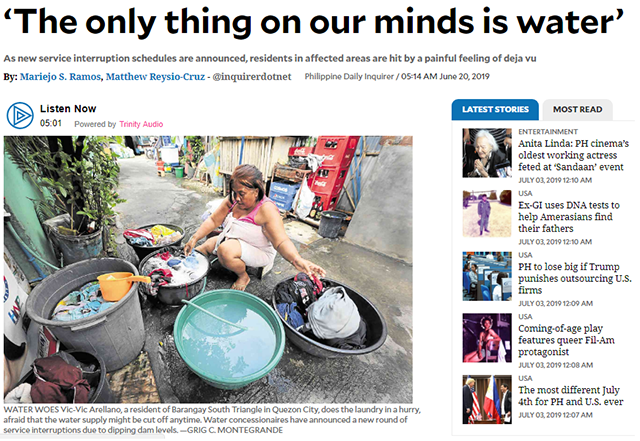Come Hell or No Water: The Continuing Crisis

CHEERS TO the Philippine Daily Inquirer for pointing out that the water shortage has been a continuing crisis in Metro Manila since March and that some areas have been suffering from extended water interruptions all this time.
Both Metro Manila water concessionaires—Maynilad and Manila Water— announced new schedules of service interruptions on June 18. But for some residents of Mandaluyong and Quezon City, this has been the norm since the crisis was first felt earlier this year.
The shortage was never fully addressed and the water levels in the Angat and La Mesa dams are falling at an alarming rate. But reports on the crisis waned after election fever overtook the issue in mid-April.
The coverage picked up again following Manila Water and Maynilad’s announcements. The media reported Philippine Atmospheric, Geophysical and Astronomical Services Administration (PAGASA) advisories on the weather, contingency measures during the crisis, and updates from the concessionaires. The Inquirer report stood out for calling attention to the plight of Mandaluyong City residents who have had water interruptions since March despite the concessionaires’ “new schedule.”
“Water Woes Back? But They Never Left”
The report focused on the accounts of residents from different barangays in Mandaluyong who have had no water even before the “new schedule” was announced. “The only thing we can think about is water,” said Sharon Mallanao who has lived for almost 40 years in Mandaluyong.
The Inquirer highlighted how the loss of water has paralyzed the residents. Some employees are unable to go to work. Some small businesses, like water refilling stations, have been forced to shut down.
A resident of Barangay San Martin de Porres said the community had gotten used to a daily water rationing schedule of 4 a.m. to 5 p.m. since March. But on June 18, their taps went dry starting at noon and lasting for 18 hours.
Although the report clearly depicted the water woes faced by Metro residents, it did not look into why urban poor residents are the most affected. Having already identified Quezon City and Mandaluyong as the areas most affected by the crisis, the report could have also looked into the basis for the water interruption cycle schedule. Media should question why some areas experience more frequent and prolonged water interruptions when the concessionaires claim that they are implementing cycles to ensure equal access to water.
The ongoing four-month long water shortage indicates a crisis in governance that warrants media attention. Merely reporting updates about the water interruption without analysis downplays the issue and absolves from accountability the thirty government agencies involved in water generation, conservation and protection.
Leave a Reply